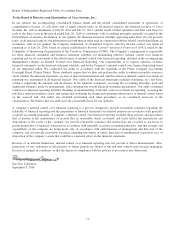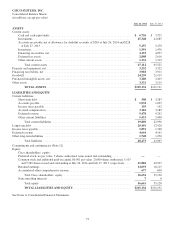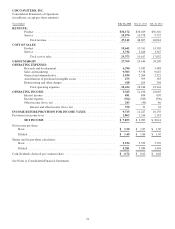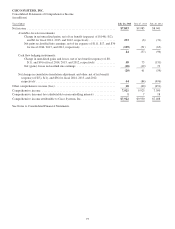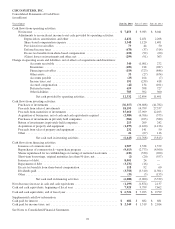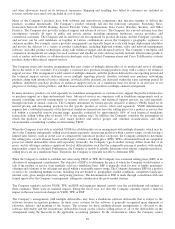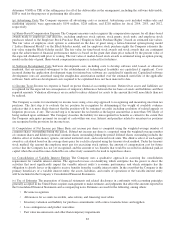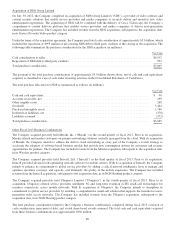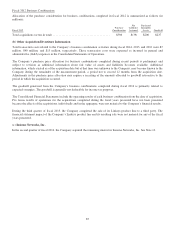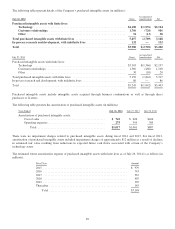Cisco 2014 Annual Report Download - page 87
Download and view the complete annual report
Please find page 87 of the 2014 Cisco annual report below. You can navigate through the pages in the report by either clicking on the pages listed below, or by using the keyword search tool below to find specific information within the annual report.
subsequent changes in facts and circumstances do not result in the restoration or increase in that newly established cost basis.
In addition, the Company records a liability for firm, noncancelable, and unconditional purchase commitments with contract
manufacturers and suppliers for quantities in excess of the Company’s future demand forecasts consistent with its valuation of
excess and obsolete inventory.
(e) Allowance for Doubtful Accounts The allowance for doubtful accounts is based on the Company’s assessment of the
collectibility of customer accounts. The Company regularly reviews the allowance by considering factors such as historical
experience, credit quality, age of the accounts receivable balances, economic conditions that may affect a customer’s ability to
pay, and expected default frequency rates. Trade receivables are written off at the point when they are considered
uncollectible.
(f) Financing Receivables and Guarantees The Company provides financing arrangements, including leases, financed service
contracts, and loans, for certain qualified end-user customers to build, maintain, and upgrade their networks. Lease receivables
primarily represent sales-type and direct-financing leases. Leases have on average a four-year term and are usually
collateralized by a security interest in the underlying assets, while loan receivables generally have terms of up to three years.
Financed service contracts typically have terms of one to three years and primarily relate to technical support services.
The Company determines the adequacy of its allowance for credit loss by assessing the risks and losses inherent in its
financing receivables by portfolio segment. The portfolio segment is based on the types of financing offered by the Company
to its customers: lease receivables, loan receivables, and financed service contracts and other.
The Company assesses the allowance for credit loss related to financing receivables on either an individual or a collective
basis. The Company considers various factors in evaluating lease and loan receivables and the earned portion of financed
service contracts for possible impairment on an individual basis. These factors include the Company’s historical experience,
credit quality and age of the receivable balances, and economic conditions that may affect a customer’s ability to pay. When
the evaluation indicates that it is probable that all amounts due pursuant to the contractual terms of the financing agreement,
including scheduled interest payments, are unable to be collected, the financing receivable is considered impaired. All such
outstanding amounts, including any accrued interest, will be assessed and fully reserved at the customer level. The Company’s
internal credit risk ratings are categorized as 1 through 10, with the lowest credit risk rating representing the highest quality
financing receivables. Typically, the Company also considers receivables with a risk rating of 8 or higher to be impaired and
will include them in the individual assessment for allowance. The Company evaluates the remainder of its financing
receivables portfolio for impairment on a collective basis and records an allowance for credit loss at the portfolio segment
level. When evaluating the financing receivables on a collective basis, the Company uses expected default frequency rates
published by a major third-party credit-rating agency as well as its own historical loss rate in the event of default, while also
systematically giving effect to economic conditions, concentration of risk, and correlation.
Expected default frequency rates are published quarterly by a major third-party credit-rating agency, and the internal credit
risk rating is derived by taking into consideration various customer-specific factors and macroeconomic conditions. These
factors, which include the strength of the customer’s business and financial performance, the quality of the customer’s banking
relationships, the Company’s specific historical experience with the customer, the performance and outlook of the customer’s
industry, the customer’s legal and regulatory environment, the potential sovereign risk of the geographic locations in which the
customer is operating, and independent third-party evaluations, are updated regularly or when facts and circumstances indicate
that an update is deemed necessary.
Financing receivables are written off at the point when they are considered uncollectible, and all outstanding balances,
including any previously earned but uncollected interest income, will be reversed and charged against the allowance for credit
loss. The Company does not typically have any partially written-off financing receivables.
Outstanding financing receivables that are aged 31 days or more from the contractual payment date are considered past due. The
Company does not accrue interest on financing receivables that are considered impaired or more than 90 days past due unless
either the receivable has not been collected due to administrative reasons or the receivable is well secured and in the process of
collection. Financing receivables may be placed on nonaccrual status earlier if, in management’s opinion, a timely collection of
the full principal and interest becomes uncertain. After a financing receivable has been categorized as nonaccrual, interest will be
recognized when cash is received. A financing receivable may be returned to accrual status after all of the customer’s delinquent
balances of principal and interest have been settled, and the customer remains current for an appropriate period.
The Company facilitates arrangements for third-party financing extended to channel partners, consisting of revolving short-
term financing, generally with payment terms ranging from 60 to 90 days. In certain instances, these financing arrangements
result in a transfer of the Company’s receivables to the third party. The receivables are derecognized upon transfer, as these
transfers qualify as true sales, and the Company receives a payment for the receivables from the third party based on the
Company’s standard payment terms. These financing arrangements facilitate the working capital requirements of the channel
partners, and, in some cases, the Company guarantees a portion of these arrangements. The Company also provides financing
guarantees for third-party financing arrangements extended to end-user customers related to leases and loans, which typically
79




